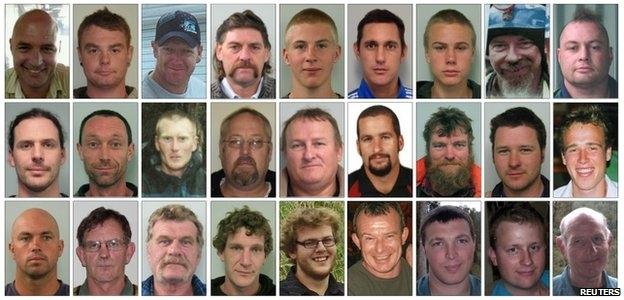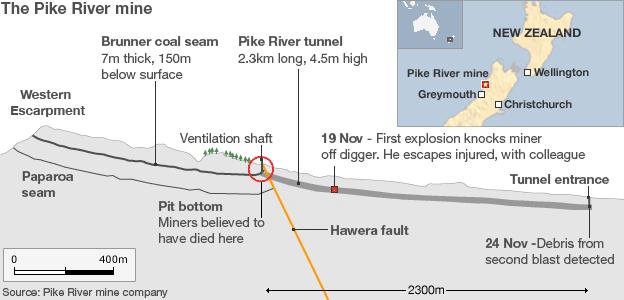New Zealand mine: 'No survivors' after second blast
- Published

The operator of the mine said it would make every effort to retrieve the bodies of the men
All 29 men missing in a New Zealand coal mine since Friday are believed to be dead after a second explosion.
Police Supt Gary Knowles said there was no hope that anyone could have survived the "massive" underground blast at the Pike River mine on South Island.
Prime Minister John Key said the deadliest mine accident in New Zealand for 96 years was a "national tragedy".
Rescuers never made contact with the 24 New Zealanders, two Australians, two Britons and a South African.
The Britons were Peter Rodger, 40, and Malcolm Campbell, 25, who were both originally from Scotland.
"Many British citizens have made their home in New Zealand and the loss of Mr Rodger, Mr Campbell and their colleagues will have touched the hearts of many in the UK," said UK Foreign Secretary William Hague.
'Still hoping'
Supt Knowles, who led the rescue operation, said there had been another explosion at 1437 (0137 GMT) on Wednesday inside the mine.
"It is our belief that no-one has survived and everyone will have perished," he told reporters.
"I was at the mine myself when this actually occurred and the blast was horrific, just as severe as the first blast and we're currently now moving into recovery phase.
"This is one of the most tragic things I have had to do as a police officer."
Rescuers had been preparing to go into the mine on Wednesday, but information suggested the levels of methane gas were too high.
Shortly afterwards, the second explosion happened. It was larger and stronger than Friday's blast, and lasted about 30 seconds, officials said.
The chief executive of Pike River Coal, Peter Whittall, said it would make every effort to retrieve the bodies of the men, aged between 17 and 62.
The BBC's Phil Mercer says rescuers must still enter the mine to search for bodies
"We want our boys back and we want to get them out," he told reporters.
Mr Whittall said the families were ''absolutely devastated by the news".
''They had all held out hope that their son, their brother would be the lucky one,'' he said, before adding with tears welling up in his eyes: "I'm unlikely to see my workmates again."
Family members wept, shouted and fell to the floor after hearing the news, Grey District mayor Tony Kokshoorn said.
"People shouted out in anger, they are sickened by the whole thing. A lot of them felt misled," he added. "It's unbelievable. This is the West Coast's darkest hour. It doesn't get worse than this."
Lawrie Drew, the father of 21-year-old miner Zen Drew, later told reporters: "I am still hoping that somebody can be found that is still alive."
The BBC's Phil Mercer in Greymouth says a church service was held on Wednesday evening to remember the dead and to comfort those left behind.
'Agonising blow'
The prime minister said he would travel to the area on Thursday to meet the miners' families and thank the rescue crews.
New Zealand Prime Minister John Key: ''We are a nation in mourning''
"New Zealand is a small country, a country where we are our brother's keeper, so to lose this many brothers at once strikes an agonising blow," Mr Key told a news conference in Wellington.
"The 29 men whose names and faces we have all come to know will never walk amongst us again. We are a nation in mourning."
He also offered his condolences to Australia, South Africa and the UK.
Mr Key praised all those involved in the rescue attempt, and said there would now be a full inquiry into how the tragedy had happened, with the aim of making sure it was not repeated.
Governor-General Sir Anand Satyanand said the disaster would be felt at many levels, and was a great personal loss for the individual families and friends of those who died.
It was not immediately clear what triggered the second blast. However, Mr Whittall said it was not thought that any rescue work caused it.
"To the best of my knowledge, absolutely nothing that was being done up there has caused this," he added. "This has come from somewhere up in the mine. We weren't doing anything in the mine other than in the fresh air and that wouldn't have caused any explosion."
Air samples taken from inside the mine through a 162m (530ft) bore-hole completed on Wednesday had shown dangerous levels of methane and carbon monoxide, preventing rescuers from entering the mine.
Two robots had been sent into tunnels of the mine and a third was on its way in the hope of gaining a clearer picture of the conditions.
Mr Drew said the miners' families were angry that rescuers had not immediately entered the mine after the first blast, before there was a build-up of gas.
"They had their window of opportunity that Friday night, and now the truth can't come out because no-one alive will be able to come out and tell the truth about what went on down there," he added.
But Mr Whittall defended the decision to keep rescue workers out of the mine. "It's dangerous and it's hazardous and the rescue teams would be putting their lives gravely at risk," he said.
"While we were there and making that assessment, exactly what we said could happen, happened."
Lawrence Drew, miner's father: "We're still hoping for a miracle"
Mining expert David Feickert told TVNZ it was likely the men became unconscious from carbon monoxide prior to the second explosion and so would not have felt the blast.
The head of the New Zealand Engineering, Printing and Manufacturing Union said rescuers would now begin a process called "gagging" the mine.
"They are going to flood it with carbon dioxide to kill any remaining burning and then there will be the exercise to recover the bodies from the mine," Andrew Little told Radio New Zealand.
He said equipment had to first be brought over from Australia, and that the operation might take one or two days.
Meanwhile, Energy Minister Gerry Brownlee said he did not believe the mine had been operating with excessive methane levels.
Pike River is not far from the Strongman Mine, where an underground explosion killed 19 men in January 1967.
New Zealand's worst mining disaster was in 1896, when a gas explosion at the Brunner mine, also near Greymouth, left 65 miners dead. It accessed the same coal seam as the Pike River mine.

- Published24 November 2010
- Published24 November 2010
- Published24 November 2010
- Published14 October 2010
- Published22 November 2010